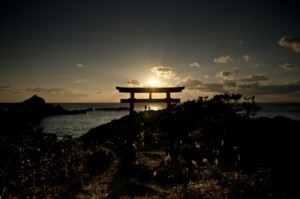お正月とは1年の最初の月のことですが、普通1日から7日までの松の内(正月の飾りを飾っている期間)または1日から3日までをこうよびます。
Shogatsu(New Year)
Although shogatsu literally means the first month of the year, it generally indicates matsuno uchi(January 1-7,during which New Year’s decorations are displayed) or first three days of January.
<お正月にまつわること>
■門松
年神様をお迎えするための目印として、新年に家の門や入り口の両側に立てるもの。門松は、松の枝を組み合わせて作った飾りに竹や梅がそえられたものです。松は長生きの象徴でもあります。
Kadomasu
A pair of decorations put at both sides of the gates or entrances of houses in order to summon the year got.Kadomatsu are decorations made with assembled pine branches enhanced by stems of bamboo and sprays of plum trees.Pine is used as a symbol of longevity.

■しめ飾り
しめ縄と同様に、お正月に家の入り口に飾るもので、魔除けの意味があります。わら、紙四手のほか、縁起のよい飾りがついています。正月が終わると門松などと一緒に神社へもっていき、焼いてもらいます。
Shimekazari
A decoration displayed at the entrances of houses during the New Year like shimenawa as a charm against evil spirits.Straw,kamishide and good luck charms are attached.When the New Year period ends, this Shimekazari , Kadomatsu and the othe decorations are taken to Shinto shrines and burned.

■しめ縄
正月に家の入り口にかけて、不浄なものの侵入を防ぐもの。
Shimenawa
A decoration put over the door of a house during New Year period to keep the evil out.

■鏡餅
大小の丸い餅を2つ重ね、神様のお供えするもの。昔、鏡は丸く、人の魂を映す神聖なものとされていたことに由来します。
Kagamimochi
A set of two rice cakes, one large and one small, stacked one on top of the other as an offering to the gods. In old times, all mirrors(kagami) were round and considered sacred objects that reflected one’s spirit.

■初日の出
神道では太陽を最も神聖なものであるとされていることから、新年最初の日の出を拝み、一年の健康と幸運を祈願します。
Hatsuhinode(the sunrise on New Year’s Day)
As the sun is considered to be the most sacred object in Shinto, people worship the sunrise on New Year’s Day to pray for health and happiness in the new year.

■初詣
新年になって初めて寺社にお参りし、その年の健康と幸運を願うもの。
Hatsumode
During the New Year period, people go for the first temple or shrine visit of the year to pray for health and happiness in the new year.

■初夢
正月2日の夜に見る夢。「一富士二鷹三なすび」というのがめでたいとされる夢の順番です。
Hatsuyume
Hatsuyume is the dream that occurs the night of New Year’s Day to the morning of the 2nd. A saying states that the best order for the dream’s subject matter is:”first,Mt. Fuji;second,hawks;third,eggplants.”
■お屠蘇
その年の邪気をはらい、長寿を祈願して年始に飲むお酒。
Toso
A special sake people drink on the New Year’s Day to prevent illness in the new year and pray for the longevity.

■お雑煮
雑煮は、餅や野菜を入れた汁で、新年を祝うためにお正月に欠かせない料理の1つです。関東地方の雑煮は四角い餅を入れたすまし汁仕立て、関西地方の雑煮は丸い餅を入れた味噌仕立てというのが一般的です。味付けや中に入れる具は、地方や家庭に寄って異なるのが雑煮の特徴です。
Zoni(Soup with rice cakes and vegetables)
Zoni is a soup with rice cakes(mochi) and vegetables and is an essential dish for celebrating the New Year. In the Kanto area, zoni is generally prepared as a clear soup with square kochi, while Kansai , it is made with bean paste and round mochi.
But the seasoning and othe ingredients are different according to each region and household.


















